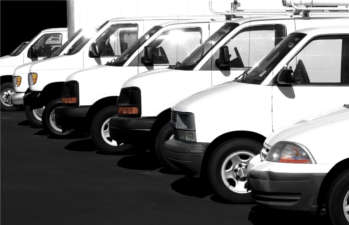A ‘van-demic’ is sweeping across the country. Recent figures revealed a boom in online shopping has led to record levels of investment in vans and trucks, as British businesses expand their fleets to deal with increasing delivery demands.
In fact, the number of vans on the roads increased by 17% this year (FT£) thanks to a rise in online shopping. And with Black Friday nearing, there can be no doubt that the number of vans on the roads, delivering customers their discounted goods, will only increase further.

Are you ready for the vans?
Of course, this paints a positive picture of a strong and growing economy. Consultancy firm OC&C even forecast that the UK ecommerce market will rise to £61bn in 2018 – a 45% growth on last year. But with more delivery vans on the road, how do we deal with the impact this has on traffic congestion levels across the UK?
In our most recent Traffic Scorecard report, we found that levels of congestion rose in three quarters of the UK’s cities during 2014, with London drivers spending up to 96 hours sat in gridlock – 14 more than the year before.
We can attribute this rise to factors such as a stronger economy, a growing UK population and rising employment rates, all of which are driving up consumer spending. But as the economy strengthens further, online shopping booms, urban populations continue to grow and road demand increases, governments and transport authorities are going to need to look to long-term solutions, in addition to the building of new infrastructure, to tackle the ever-growing congestion problem.
We should, therefore, turn our attention to smart, data-led solutions. In the rise of the Internet of Things, Gartner predicts that by 2020 there will be a quarter of a billion connected vehicles on the road. By gathering the billions of data points from these connected cars every day, we can start to build a more accurate picture of the situation on the roads, at any given time, and set about making the necessary remedial actions.
Having access to real-time information across a city’s infrastructure provides transport agencies and city planners with valuable information and insights into the situation on the roads at any given time. With an accurate picture of what is happening on the roads, governments and transport authorities are able to better manage traffic in the region.
In addition, by making this data available to drivers in real-time, they too have access to valuable information to make them aware of the traffic situation while on the road. Solutions, such as smart parking and providing drivers with real-time information about congestion hotspots via mobile apps or in-car dashboards, makes route planning easier and this too has positive consequences on congestion.
We can see this happening across some of the cities analysed in our Traffic Scorecard report. Those that installed real-time, data-led solutions, such as smart parking, over the past few years have actually seen a fall in the time drivers spent in traffic year-on-year. Whilst we cannot outright claim that such solutions caused this decrease, with the knowledge that up to 30% of traffic in congested urban areas is the result of drivers searching for parking, we can make an educated guess that such solutions contributed to the fall in congestion.
Therefore, if governments and transport authorities are going to tackle the congestion problem, in which this ‘van-demic’ plays a significant role, they need to be armed with accurate information into what is happening on the roads right now. Only by having access to this insight, in real-time, can the right remedial actions be taken and we avoid the risk of spending any further time wasted in gridlock.
Graham Bradley, Senior Director & UK Country Manager, INRIX